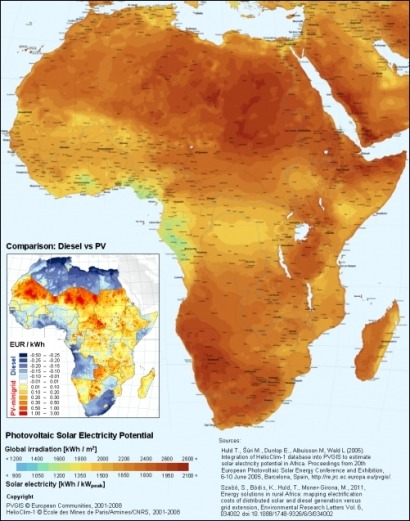
The map of Africa's solar electricity potential, for example, based on the JRC's Photovoltaic Geographical Information System (PVGIS), shows that in many parts of Africa the same photovoltaic panel could produce twice as much electricity as it would produce in Central Europe.
However, in order to assess the suitability of solar energy to provide electricity in rural areas, this option has to be assessed against costs for grid extensions and with the traditional diesel generators. A combined analysis of photovoltaic systems, grid extensions and diesel options shows for each area which option is the most cost efficient.
In Northern Africa, the promising potential of renewable energies, in particular solar and wind energy, has to compete with cheap fossil fuel. Meanwhile the challenge in the Sub-Saharan regions is to improve sustainability and efficiency of traditional biomass use and to provide a suitable alternative to biomass overexploitation. This alternative should be based on cleaner energy sources, particularly in Sub-Saharan Africa where firewood and charcoal represent 80% of total energy use and where most of the population lives in rural areas with no access to electricity.
Small hydroelectric power plants have strong potential in Equatorial Africa due to an extended network of permanent rivers and the fact that most households are located closer to a river than to an existing electricity grid.
Considering the current grid infrastructure, the report suggests that wind energy is the most exploitable on a larger scale in northern parts of Africa, in particular along the Mediterranean coast, and in the most southern parts of the continent.
As for biomass, the report highlights a dramatic difference between the EU and Sub-Saharan Africa in the efficiency of the production and use of this fuel and discusses the development of a wood fuel sustainability index and the unexploited potential of energy crops like sugar cane.
The Joint Research Centre (JRC) is the European Commission's in-house science service. Its mission is to provide customer-driven scientific and technical support for the conception, development, implementation and monitoring of European Union policies. The JRC serves the common interest of the Member States, while being independent of special interests, whether private or national.
For additional information:

